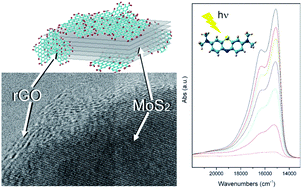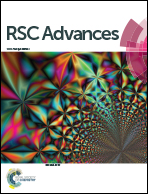Designing rGO/MoS2 hybrid nanostructures for photocatalytic applications†
Abstract
Graphene and its derivatives exhibit large surface area, being ideal templates to facilitate the nucleation, growth or interaction of a huge variety of structures. Among them, molybdenum disulphide, with its structural and morphological compatibility with graphene, can be a candidate for achieving an excellent integration, to make new hybrid nanocomposites with outstanding characteristics. Among the synthesis methods of graphene/MoS2 composites, the solution-phase exfoliation of a MoS2/graphite mixture, by means of ultrasounds, shows significant advantages in terms of large amount production without altering the main properties of 2D nanomaterials. Moreover MoS2, having a strong absorption in the visible, has been exploited as a novel visible light-sensitive semiconductor photocatalyst. But, due to the quick recombination of photo-generated charge carriers, the photocatalytic efficiency of MoS2 has to be further improved. Graphene and graphene related materials, as excellent electron-acceptor/transport materials, have been applied to photocatalysis, because they are able to decrease the photo-generated electron–hole recombination, thus improving the light absorption. Therefore, MoS2 and graphite oxide (GO) have been simultaneously sonicated in an ethanol/water mixture and characterized from the structure, morphology and electronic properties point of view. The composite was thermally treated in such a way to reduce GO and the photocatalytic activity of the reduced GO/MoS2 has been investigated by means of UV-vis spectroscopy, following the degradation of methylene-blue (MB) under solar-like irradiation.

- This article is part of the themed collection: 2D Materials: Explorations Beyond Graphene

 Please wait while we load your content...
Please wait while we load your content...